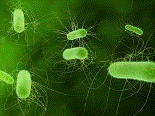Gut Function Initiative

Andrew Benson Publications
ORCID IDs
E Williams 0000-0002-9746-376X
Brewer 0000-0002-6810-1911
Andreux 0000-0001-9841-8509
Bastiaansen 0000-0002-6562-176X
Kachman 0000-0003-0506-513X
Auwerx 0000-0002-5065-5393
Benson 0000-0001-6330-0252
Ciobanu 0000-0002-7301-1339
Document Type
Article
Date of this Version
6-2012
Citation
PLoS One 7(6): e39191
doi: 10.1371/journal.pone.0039191
https://journals.plos.org/plosone/article?id=10.1371/journal.pone.0039191
Abstract
The gastrointestinal tract harbors a complex and diverse microbiota that has an important role in host metabolism. Microbial diversity is influenced by a combination of environmental and host genetic factors and is associated with several polygenic diseases. In this study we combined next-generation sequencing, genetic mapping, and a set of physiological traits of the BXD mouse population to explore genetic factors that explain differences in gut microbiota and its impact on metabolic traits. Molecular profiling of the gut microbiota revealed important quantitative differences in microbial composition among BXD strains. These differences in gut microbial composition are influenced by host-genetics, which is complex and involves many loci. Linkage analysis defined Quantitative Trait Loci (QTLs) restricted to a particular taxon, branch or that influenced the variation of taxa across phyla. Gene expression within the gastrointestinal tract and sequence analysis of the parental genomes in the QTL regions uncovered candidate genes with potential to alter gut immunological profiles and impact the balance between gut microbial communities. A QTL region on Chr 4 that overlaps several interferon genes modulates the population of Bacteroides, and potentially Bacteroidetes and Firmicutes–the predominant BXD gut phyla. Irak4, a signaling molecule in the Toll-like receptor pathways is a candidate for the QTL on Chr15 that modulates Rikenellaceae, whereas Tgfb3, a cytokine modulating the barrier function of the intestine and tolerance to commensal bacteria, overlaps a QTL on Chr 12 that influence Prevotellaceae. Relationships between gut microflora, morphological and metabolic traits were uncovered, some potentially a result of common genetic sources of variation.


Comments
Copyright 2012, the authors. Open access material
License: CC BY